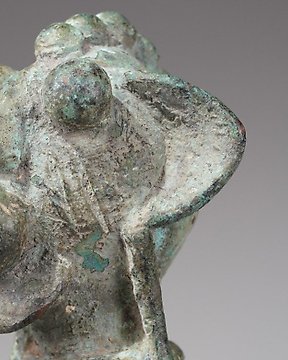
维尔 - 尼日利亚 (没有保留价)
编号 82977647

编号 82977647

A fragmentary Brass Plate in the style of Benin, with the Oba nin the center. He wears the attributes of his dignity: a hairstyle and necklaces made of coral pearls, a baldric made of several rows of pearls across his torso, a necklace made of leopard teeth, as well as bracelets, anklets and leggings. His draped loincloth is tied at the side and is secured by an anthropomorphic belt mask, also called “hip-mask”. He brandishes the eben, his ceremonial sword. to his right and left two high-ranking warriors with shields that express the protection of the king. Also five smaller figures with musicinstruments, a sword and a drinking bottle. Although the plate only survived as a fragment, the large number of eight people in the half-relief shows the astonishing skill of this caster.
Stylistically, the Plate belongs to the time of Oba Esigie, who ruled from 1504 to 1550 and brought Benin art to its high point, which caused Felix von Luschan to compare the art of Benin with the Renaissance sculptor Benvenuto Cellini 1500 - 1570. He expressed it in the way "that the art of Benin is in no way inferior to the work of Cellini." The assignment to the reign of Esigie is also based on the research of Kathryn Wysocki Gunch*, which is based on her studies about the flanges of the Benin plates. She came to the conclusion that the doubled wooven ornaments (s. no. 3 of this photosequence) )belong to the late phase of Benin art.
Source: British Museum, looted in 1897, more info on Digital Benin
to this object and its history. inventory No. Af1898,0115.86
“The relief brass plaques that used to decorate the Oba's (king's) palace are among the most well-known of all the royal arts of Benin. Although frequently described as 'Benin Bronzes' most plaques are made of leaded brass in various compositions. It is widely accepted that they date to the 16th-17th centuries. In the years prior to the British Expeditionroyal influence in Benin was increasingly under threat from rival powers, both internal and external, with a focus on economic power and control of the important trading monopolies. However, the court and palace remained the political and spiritual centre of the Benin Kingdom. Earlier accounts written by Europeans visiting the city describe its size and scale. The palace complex was set up around atrium courtyards; some had galleries with wooden pillars supporting the roof. Brass plaques, probably made in matching pairs, were fixed to these pillars. The Benin brass plaques represent a distinct and unique corpus of work, unparalleled elsewhere on the continent. They are cast using the cire perdue (lost wax) technique and show significant variation in the depth of the relief. Some of the plaques portray historical events or commemorate successful wars, while others are a vivid depiction of Benin court life and ritual. Several groups of plaques show clear stylistic similarities. William B. Fagg suggested that these plaques represent the work of master brass casters. Fagg, William, 1973, 'Nigerian Images', London: Lund Humphries Gunsch, Kathryn, 2018, 'Benin plaques: a 16th century imperial monument', London: Routledge, Taylor and Francis Group..a stolen plate by the British occupation of Benin City (Edo) in 1897, which was exhibited in the British Museum..” Source: Digital Benin, Registration Number object Af1898,0115.86
* Lit. Kathryn Wysocky Gunch, The Benin Plaques, The 16th century bronze plaques from the kingdom of Benin
TL-Analysis is available on request.
Height: 48 cm
Length: 41 cm
Weight: 9,1 kg